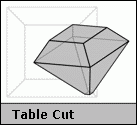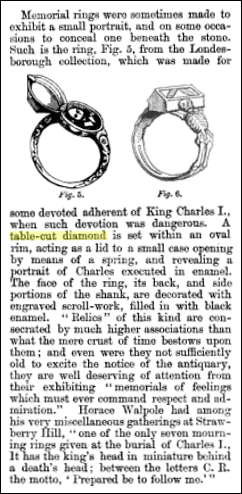Table Cut Diamond
Is the modern definition of the table cut diamond a case of mistaken identity? Read on for another Diamondcuts.com exclusive!
The original Table Cut Diamond is one of the earliest diamond shapes - and can be seen as the first step towards the diamond shapes that are popular today. The basic or "full" table cut was developed from the point cut (a basic octahedral shape) by truncating the uppermost point of the octagon, leaving a flat table at the top of the stone - a name that has been used for the uppermost facet ever since. The table cut was a predominant style used until the beginning of the seventeenth century. [1]
The table cut was popular in the renaissance period, however few of these stones have survived; as with other old diamonds, most of them were recut into modern brilliants. Even though some of the stone was removed in this process, the increased value of the brilliant outweighed the loss incurred.
An alternative modern definition of the table cut is that the term includes any diamond which has a table facet. These diamonds have been cut in the classic "diamond shape" - with a table uppermost, a shallow crown and a pavilion going down to a point or near-point below. This definition includes modern brilliants, princess and baguette cuts as well as the "specific" table cut. [2]
The Mirror Cut
One variation on the table cut that was often seen in old times was the Mirror cut, also known as the spread table cut - and this is simply a table cut with a much enlarged table and very thin upper girdle facets, giving the crown the resemblance of a mirror with bevelled edges. The mirror cut was sometimes performed in order to maximize the yield from a shallow macle (triangular, twinned rough diamond). [3]

Table Cut Diamond
"Modern definition" -
diagram by Juergen Schoner (2004),
- image lic. under CC-BY-SA-3.0

Table Cut Diamond Ring
(Fig.5) - From the "Art Journal", 1865
The Double Table Cut Diamond
In modern times, the definition of the table cut is that there is only one table - on the crown - and a deep pavilion - as in the diagram on the left. However it appears that prior to 1900, the term table cut diamond may have been used to signify a gem that had tables cut both above and below; giving a flat, tabular overall shape, the pavilion identical in style to the crown. Simple line diagrams of this cut can be seen in books from 1878 and 1902 [4] [5] (The diagram from Chambers's 1878 Encyclopaedia is reproduced verbatim in various encyclopaedias of the time.) Also there appears just one modern example online of a stone (a 7ct quartz) wearing such a cut and described as a double table cut diamond. [6]
Several other old books describe the table cut diamond as being a flat stone - but most intriguing of all is the entry in the Art Journal, vol. 27 (1865); describing a fascinating manner in which a table cut diamond was used: To create an upper surface for a "devotionary picture ring" in times when such devotion was dangerous. A picture is given of an antique ring in the Londesborough collection - and the illustration is reproduced here with its adjoining description. The stone appears to be completely flat below, and used to cover a portrait. This may have been achieved by splitting a table cut diamond into two "panes". [5] Nor was this unique; the Smart Set - A Magazine of Cleverness (1904) features a short story in which one of the characters exclaims "Mama is talking of having her canary done by some celebrated miniaturist, for a ring, you know, to be set under a table-cut diamond." [7] In such a case the only logical cut would be flat both above and below - as any other pavilion facet arrangement would occlude the image underneath.
In conclusion, although the old books simply describe such stones as table cut diamonds, given that the modern understanding of the table cut is of a gem with one table and a deep pavilion, these extremely rare varieties of table cut diamond can only really logically be described as either double table cut diamonds or flat bottomed table cut diamonds.
The Shah Jehan Table Cut Diamond
Perhaps the most famous table cut diamond of all time is the mysterious Shah Jehan Table Cut Diamond. This 56.71 carat stone, like so many other famous diamonds, has origins disappearing into the mists of time. It appears and disappears at various times throughout history, leaving only vague descriptions and multiple guesses as to its true identity. It is thought by some to have been one of the diamonds recorded by Tavernier in 1665. It appeared at auction at Christies, Geneva in May 1985; however the stone was not sold.
The origin of this diamond is speculative: It is called the Shan Jehan as it closely resembles a diamond in the turban of Shah Jehan in a portrait housed in the Victoria and Albert Hall Museum, London. Shah Jehan was most famous for his extravagant architectural and artistic commissions, notably the Taj Mahal and his supremely lavish throne. [8] [9]

See more Diamond cuts
Table Cut Diamond info sources:
[1] http://books.google.com/books?id=dxFUAAAAMAAJ&pg=PA278
[2] http://www.langantiques.com/university/index.php/Table_Cut
[3] http://www.langantiques.com/university/index.php/Table_Cut#Mirror_or_Spread_Table_Cut
[4] Chambers's Encyclopaedia, 1878 - http://books.google.com/books?id=IKiL587Xx2MC&pg=PA536
[5] http://books.google.com/books?id=OcBOAAAAMAAJ&pg=PA535
[6] http://jewelry.hsn.com/gem-designs-by-palermo-8-25ct-white-quartz-and-multigemstone-14k-bridge-ring_p-4490728_xp.aspx
[7] http://books.google.com/books?id=_HtHAAAAYAAJ&pg=RA1-PA28
[8] http://famousdiamonds.tripod.com/shahjahantablecutdiamond.html
[9] http://www.langantiques.com/university/index.php/Shah_Jehan_Table-Cut
Note - this website is intended for general informational and entertainment purposes, and should not be considered to be professional consultation. If you are considering purchasing precious stones, be sure to seek the advice of a qualified professional.

